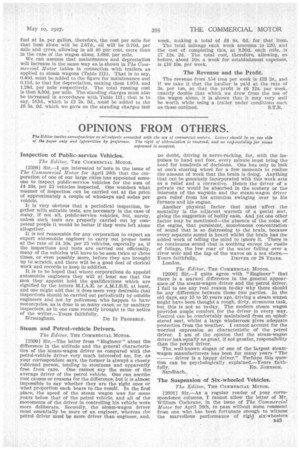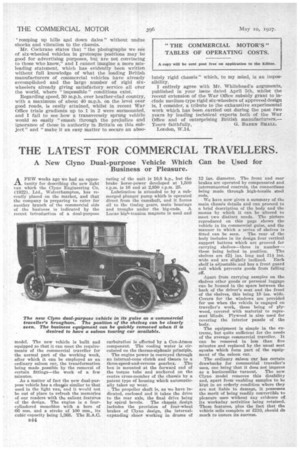OPINIONS FROM OTHERS.
Page 69

Page 70

If you've noticed an error in this article please click here to report it so we can fix it.
The Editor invites correspondence on all subjects connected with the use of commercial motors. Letters should be on one stets of the paper only and typewritten by preference. The right of abbreviation is reserved, and no responsibility for views
expressed is accepted.
Inspection of Public-service Vehicles.
The Editor, THE COMMERCIAL Mo
[2598] Sir,—I am interested to note in the issue of The Commercial Motor for April 26th that the corporation of one of our large cities has appointed someone to inspect public-service vehicles for the sum of £4 10s. per 25 vehicles inspected. One wonders what manner of inspection can be carried out at the price of approximately a couple of whiskeys arid sodas per vehicle.
It is very obvious that a periodical inspection, together with suitable tests, are necessary in the case of many, if not all, public-service vehicles, but, surely, unless such tests are properly carried out by competent people it would be better if they were left alone altogether.
It is not reasonable for any corporation to expect an expert automobile engineer to carry out proper tests at the rate a £4 10s. per 25 vehicles, especially as, if the inspections and tests are carried out efficiently, many of the vehicles will have to be seen twice or three times, or even possibly more, before they are brought up to scratch, and there will be a good deal of clerical work and records to keep in addition.
It is to be hoped that where corporations do appoint automobile engineers they will at least see that the men they appoint hold the qualifications which are signified by the letters M.I.A.E. or A.M.I.E.E. at least,, and one might add that it does seem very desirable that inspections should be carried out periodically by outside engineers and not by policemen who happen to have motorcycles, as is done in so many eases, or by sanitary inspectors, as in one case recently brought to the notice of the writer.—Yours faithfully,
Birmingham. Do IT PROPERLY.
Steam and Petrol-vehicle Drivers.
The Editor, THE COMMERCIAL MOTOR.
r2599] Sir,—The letter from "Engineer" about the difference in the attitude and the general characteristics of the steam-wagon driver as compared with the petrol-vehicle driver very much interested me, for, as your correspondent says, the former is alwayS a cheery rubicund person, tending to stoutness and apparently free from care. One cannot say the same of the average driver of the petrol vehicle. One can ascribe root causes or reasons for the difference, but it is almost impossible to say whether they are the right ones or what proportion each bears to the result. In the first place, the speed of the steam wagon was for some years below that of the petrol vehicle, and all of the movements of the driver in controlling his vehicle were more deliberate. Secondly, the steam-wagon driver must essentially be more of an engineer, whereas the petrol driver must be more driver than engineer, and.
no doubt, driving is nerve-racking, for, with the impulses to hand and foot, every minute must bring the need for hundreds of decisions. One has only to look at one's steering wheel for a few moments to realize the amount of work that the brain is doing. Anything that can be genuinely incorporated with this wolk acts as a relief and a corrective. Hence the driver of a private car would be absorbed in the scenery or the interests of the wayside and the steam-wagon driver gets relief from his attention swinging over to his furnace and his engine.
Another physical factor that must affect the mentality is the adjacent warmth of a genial sort, giving the suggestion of bodily ease. And yet one other factor may be mentioned—the absence of the noise of the engine, that persistent, monotonous concentration of sound that is so distressing to the brain, because every separate sound is heard whilst the brain has the added work of telling the mind to ignore it. There is no continuous sound that is soothing except the rustle of foliage, the low roar of the water falling over a river weir and the lap of the waves on a sea shore.—
Yours faithfully, DRIVER or 28 YEARS. London,
The Editor, THE COMMERCIAL MOTOR.
[2600] Sir,—I quite agree with "Engineer" that there is a marked difference in the general appearance ,of the steam-wagon driver and the petrol driver. I.fail to see any real reason to-day why there should be any difference between these two parties. In the old days, say 15 to 20 years ago, driving a steam wagon might have been thought a rough, dirty, strenuous task, but this is not so to-day. The modern steam wagon provides ample comfort for the driver in every way. Control can be comfortably maintained from an upholstered seat, whilst a large windscreen gives adequate protection from the weather. I cannot account for the worried expression so characteristic of the petrol driver. I am of the opinion that the steam-wagon driver has equally as great, if not greater, responsibility than the petrol driver.
The well-known slogan of one of the largest steam wagon manufacturers has been for many years "The
driver is a happy driver." Perhaps this question can be psychologically explained.—Yours ED. JonNsore
Sa.ndbach.,
The Suspension of Six-wheeled Vehicles.
The Editor, THE COMMERCIAL MOTOR.
[2601] Sir,—As a regular reader of your correspondence columns, I cannot allow the letter of Mr. William Cochrane, in the issue of The Commercial Motor for April 26th, to pass without some comment from one who has been fortunate enough to witness the marvellous performance of rigi six-wheelers romping up hills and down dales" without undue shocks and vibration to the chassis.
'Mr. Cochrane states that "the photographs we see of six-wheeled vehicles in grotesque positions may be good for advertising purposes, but are not convincing to those who know," and I cannot imagine a more misleading statement, which has evidently been written without full knowledge of what the leading British manufacturers of commercial vehicles have already accomplished and the large number of rigid sixwheelers already giving satisfactory service all oter the world, where " impossible " conditions exist.
Regarding speed, 30 m.p.h. over heather-clad country, with a maximum of about 40 m.p.h. an the level over good roads, is easily attained, whilst in recent War Office trials gradients up to 1 in 2 were surmounted, and I fail to see how a transversely sprung vehicle would so easily "smash through the prejudice and ignorance of those in authority in Britain on this subject" and "make it an easy matter to secure an abso
lutely rigid chassis" which, to my mind, is an impossibility.
I entirely agree with Mr. Whitehead's arguments, published in your issue dated April 5th, whilst the recent extension of the War Office subsidy grant to include medium-type rigid six-wheelers of approved design Is, I consider, a tribute to the exhaustive experimental work which has been carried out during the past two years by leading technical experts both of the War Office and of enterprising British manufacturers.— Yours faithfully, G. BADEN SMALL. LDI1d011, W.14.




















































































































